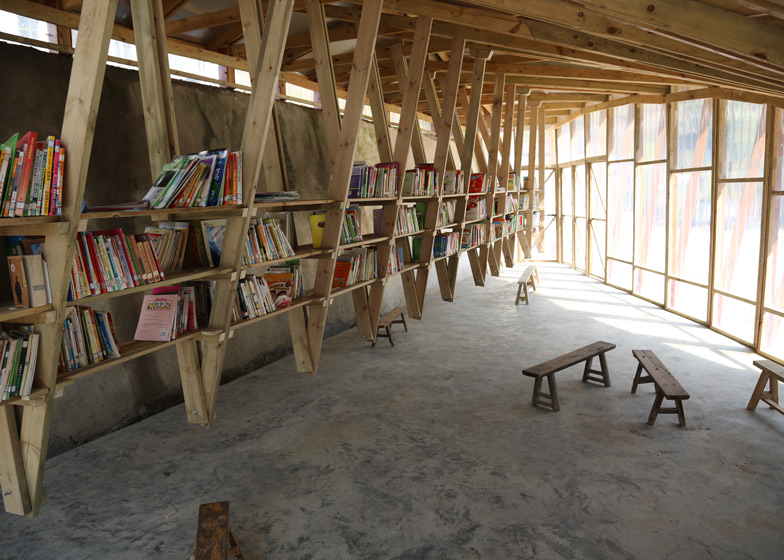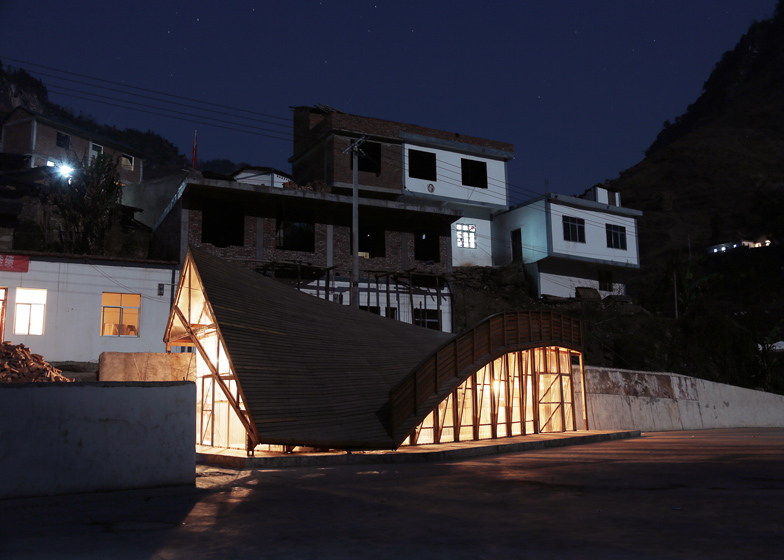Children can clamber onto the curved roof of this community library in China, which architects John Lin and Olivier Ottevaere designed for an earthquake-damaged village in Yunnan Province (+ slideshow)
Ottevaere and Lin led a team from the University of Hong Kong to design The Pinch, a library and community centre built as part of a government reconstruction following the 2012 Yunnan earthquakes.
Situated in the mountain village of Shuanghe in south-west China, the library and surrounding plaza offers a meeting place for local residents, as well as a space where children can play and read.
"Villages in China often prioritise building houses over community spaces and community programs, even though it is an important aspect of village life," Lin told Dezeen.
"Although the government provided an open plaza for the reconstruction, we wanted to help introduce a program which would activate the site. By adding the library, we have created an important public and communal facility in the village," he explained.
The library features a twisted shape that bends out to meet an elevated stretch of pavement, allowing visitors to walk over the roof and look out towards a new basketball court.
Inside, rows of books sit on shelves made from interlocking timber frames, which are suspended from the ceiling and hover just above the floor.
Simple school benches offer flexible seating, while polycarbonate plastic doors and windows front the building.
The project was part-funded by the University of Hong Kong. Forming part of a knowledge exchange project, the design team worked with a local timber company to learn about native wood and regional construction techniques.
Here's a project description from the design team:
The Pinch: library and community centre
The Pinch is a library and community centre in Shuanghe Village, Yunnan Province, China. The project is part of a government-led reconstruction effort after an earthquake in Sept 2012. The majority of village houses were destroyed, leaving the residents living in tents for up to one year. After the earthquake the government has sponsored new concrete and brick houses and a large central plaza. During the first site visit, the houses remained incomplete and the plaza was a large empty site.
The University of Hong Kong decided to sponsor the design and implementation of a new library building. Located in the new but empty public plaza, it would serve to activate the community and provide a physical memorial for the event. The site of the library is against a 4 meter high retaining wall. The design spans across this level difference and acts as a bridge between the rebuilt village and the new memorial plaza. Emphasising its location in a remote mountain valley, the design responds visually to the space of the valley, offering stunning views across a dramatic double curved roof. The structure itself rises to a peak, a monument to the earthquake and rebuilding effort.
As a Knowledge Exchange Project, the construction involves collaboration with a local timber manufacturing factory. The process resulted in the development of a surprisingly diverse form through simple means. A series of trusses is anchored between the upper road level and lower plaza level.
The form of each truss changes to create both a gradual incline (to bring people down) and then a sharp upward pitch (to elevate the roof). The trusses were covered in an aluminium waterproofing layer and timber decking. On the interior, the trusses extend downward to support a floating bookshelf. Simple traditional school benches are used as chairs. The polycarbonate doors can open to create a completely open space extending out to the plaza.
Rather than submitting to the abandonment of wood construction (as with the houses after the earthquake), the project reasserts the ability to build contemporary timber structures in remote areas of China.
Location: Shuanghe Village, Yunnan Province, China
Design: Olivier Ottevaere and John Lin / The University of Hong Kong
Construction: Kunming Dianmuju Shangmao Company
Funding: Supported by the Knowledge Exchange Impact Award, HKU
Project Team: Crystal Kwan (Project Manager), Ashley Hinchcliffe, Connie Cheng, Johnny Cullinan, Jacky Huang
Size: 80 sqm
Cost: 130,000 rmb
Unit Cost: 1600 rmb/sqm











